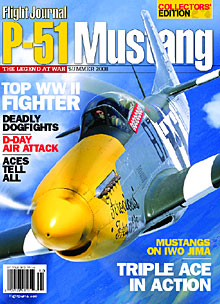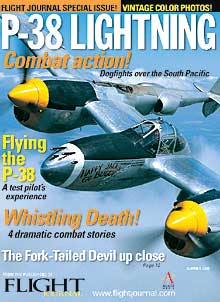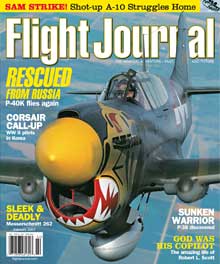B-17 Flying Fortress
$7.99
| When World’s Collide An unusual mid-air and a heroic effort James Busha When the B-17’s “The Little Skipper” and “Nine Lives” both moved into fill an empty slot in a formation, they slammed together and their fates were, from that point on intertwined. On top of the stack, “The Little Skipper’s” pilot Lt. Glenn Rojohn and co-pilot William Leek, fought to control the tangled assemblage and flew it all the way to the ground. An amazing tale of survival. | |
Next Stop Sweden Shot up and low on fuel, it was the only option Ed Cantilli, Kathryn Budde-Jones, Chris Bucholtz The Me 210s were making hash out of them and there wasn’t a thing Lt. Gillespie could do about. Using their 20mm cannons, the Luftwaffe pilots stayed just out of range of the B-17s armament, eventually blowing half the tail away and causing one engine to seize. As the B-17 crew tried to make it back to England the choice became obvious: bail out into the English Channel, which was suicide, or try for neutral Sweden. Sweden looked much more inviting. If they could make it, that is. | |
Swamp Ghost B-17E Gravesite in the New Guinea wetlands Justin Taylan The raid on Rabaul was disappointing. Four of the five B-17s on the raid had been hit and B-17E 41-2446 was stricken from the inventory when its crew had to belly it into a swamp in New Guinea as it ran out of fuel. For 60 years, it remained where it landed. Occasionally visited by the curious and scavengers, this time it was visited by Justin Taylan and his camera. See this glorious ghost from the past as it lives out its final days as the most complete B-17 wreck known to exist. | |
The Saga of Sea Hag Propeller Problems Lead to a Channel Ditching Jack Goetz, Win JAckson III This time the enemy was mechanical failure, not flak or fighters. But the result was exactly the same. From the moment they started to taxi, they knew their airplane was not healthy, but as they crossed into France, mechanical gremlins ganged up on them until they had one engine on fire and another with a runaway propeller. They’d never make it home and the frigid English Channel was to become their runway, and survival was in doubt. | |
Low Level Raid 12 hours of flying and fighting Jan Tegler It was Easter morning 1944, and the Baltic Sea was barely 50 feet below the twisting, squirming B-17 as it did its best to present a poor target for the five Me 210s and their never ending attacks. With one engine out, “”Hi Fever”” should have been an easy target, but in the end, several Messerschmitts hit the water and one very bullet-ridden B-17 made it home. | |
Fortress from the Beginning An overview of the early B-17 models Warren Bodie The Model 299 was Boeing’s privately financed gamble that the Army would want their four-engine bomber, even though they hadn’t actually asked for it. And, as historian Warren Bodie points out, it was a gamble that paid off handsomely for both the company and the nation. Through words and original photos, Bodie takes us from the early days of the Model 299 into the production line B-17s that were the backbone for America’s venture into Fortress Europe. | |
Lucky Thirteen A B-17 barely survives the first Schweinfurt raid Jan Tegler Lucky Thirteen turned out to be truly lucky, although not without its share of trouble and wounded crewmen. In terrifying detail, one of its waist gunners describes the relentless hammering their airplane took on one of the bloodiest and most historic raids of WWII: the first raid on the ball bearing factories at Schweinfurt. | |
Low Flak Railroad gunn ack-ack cripples a Fort Clarke Ash Fighters were relentless, but at least the B-17’s gunners could fight back. Flak, however, was nothing more than a crap shoot, and on Clarke Ashe’s second flight as a copilot, he found that fate truly is the hunter. Nearly over Allied lines on the return flight at low altitude, a railroad gun put a burst barely off their nose and their routine flight turned into a race against time for a crew member. | |
Milk Run through Hell An unbriefed crew causes a disaster James Busha It was April, Friday the 13th, 1945. To make matters worse, during the mission brief, the bad news came down that President Roosevelt had died the night before. It was not to be a good day for Lt. Traeder’s crew, although all would survive. Barely. Their airplane and five others of their 10-plane group, however, wouldn’t survive. The bombs they carried were experimental units and, as with all experiments, things sometimes go wrong and this time many good men died as the result. |











